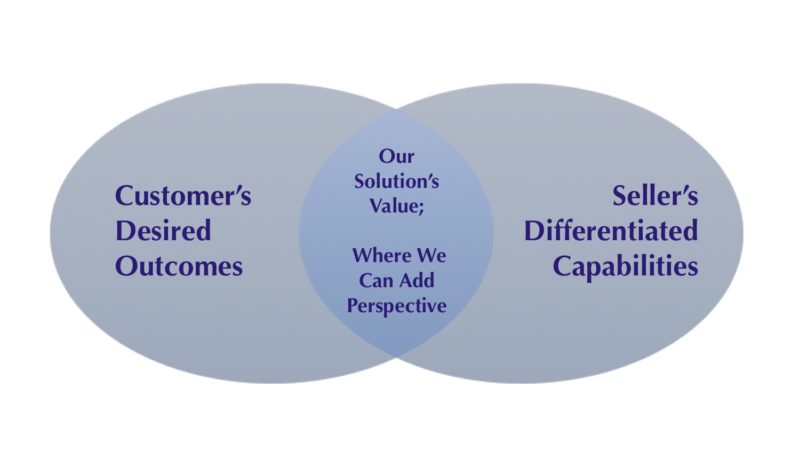
By Mark Boundy
Know Your Product/Service Through the Customer’s Perspective
Know Your Product/Service Through the Customer’s Perspective https://csuiteold.c-suitenetwork.com/advisors/wp-content/themes/csadvisore/images/empty/thumbnail.jpg 150 150 Mark Boundy https://secure.gravatar.com/avatar/fda1708afcd4681826f4fb12f56401d9?s=96&d=mm&r=gPart Three of a Five-Part Series.
You need solution acumen (product or service…applied to the customer situation) to craft win-win solutions.
Previously, I introduced perspective: knowledge or insight that expands a customer’s understanding of one or more business issues. When a seller provides perspective, they apply customer-valued(not just any) insights and expertise about unanticipated outcomes.
Then, I introduced a three-legged stool: the three foundational areas of expertise a seller should possess:
- Business Acumen...The focus of part two. Basically, this type of expertise equips you evaluate a prospective customer’s (or any company’s) operational efficiency and effectiveness, then identify value gaps.
- Solution Acumen.
- Customer Acumen…Where we will go in part four
Today’s topic: Solution Acumen
First of all, solution acumen is waaaaay more than simple product knowledge. I’ve met sellers who are experts on their products/services, but have only a vague inkling why a customer might care. Consequently, they have product knowledge without solution acumen. Ultimately, here’s the source of the disconnect:
Customers don’t buy our products or services. Instead, they buy results. That is, they buy outcomes our products or services deliver into their lives and businesses.
Importantly, solution acumen means that you can articulate a relationship between properties of your offer and customer-valued outcomes. Knowing your product or service is something. Knowing all about how your product or service adds value to a customer is everything.
In addition, the price they’ll willingly pay for your solution depends on clarity, certainty, and desirability of those outcomes.
Ultimately, profitability happens when you provide more value for your customer than it costs you to produce. You can only price profitably in two ways: by accident, or by understanding – and pricing to – your customer’s outcomes. To achieve the latter, you need solution acumen.
What Solution Acumen Typically Looks Like:
Generally, solution acumen comes in degrees. As sellers go from basic product knowledge to full solution acumen, here are some of the identifying characteristics:
Basic solution knowledge includes:
- Specs, performance…information a subject-focused persona wants to know.
- Available product or service options. At a basic level, every seller should understand how their offer can be stripped down, augmented, and/or bundled.
- Commercial policies. Similarly, basic-level knowledge includes ordering procedures, lead times, implementation basics, pricing, available discounts, and the like.
- Competitors: An essential understanding includes basic competitor profiles, product descriptions, etc.
Intermediate-level offer knowledge might look like:
- Typical configurations offered, even configurations commonly purchased for specific segments.If your company has developed a standard “small business package”, this mid-level knowledge has been institutionalized.
- Commercial policies: Above basic level, understand discounting flexibility, how the pricing exception system really works (how the game is played in your company), have complete knowledge of any implementation process, how to expedite orders, etc.
- Competitive differentiation. In this area, sellers can articulate competitive differences, and confirm/gauge strength of customer reactions to those differences.
Advanced knowledge, aka Solution Acumen is outcome-based, and is characterized like this:
- Applications/use cases have been modeled, and all affected buying personas’ interests can be articulated.
- Sellers can map competitive differentiation to customer outcomes. As an aside, my value networks are one way to do this.
- Ability to brief implementation teams with persona-specific outcomes identified during deal pursuit. A key part of solution acumen is delivering on world-class outcomes after the sale.
- Additionally, sellers move beyond descriptions of outcomes to quantifying them (measuring outcomes in monetary terms) with prospective customers. Also, instead of mastering the ins and outs of discounting, sellers master upward pricing flexibility: understanding attainable price premium and the required customization in order to fairly and legally price at a win-win price premium.
How Solution Acumen Shapes Perspective Selling
Solution acumen enables sellers to build connections between their offer and customer-valued outcomes. To see how, look at the Venn diagram below:

Customers have value gaps, shown on the left oval. That is, they have unmet needs and aspirations. Suppliers differentiate themselves through unique capabilities. With solution acumen, sellers’ capabilities are expressed in customer terms — outcomes,– so that customers overlap the two ovals. Any overlap represents where sellers can provide value. Only in this overlap is where sellers perspective welcomed.
Solution acumen increases as sellers more clearly translate the right-hand oval from “we provide ____” to “you achieve _____”. In fact, this is why solution acumen is so important. As a result, sellers who clearly articulate a cause/effect relationship between offer/outcome become trusted business advisors.
With perspective, sellers can add to the overlap by:
- Proposing new possible outcomes,
- Framing the customer situation differently…in a way that promises a better outcome
- Framing the decision differently…again, to yield a valued outcome.
Remember, customers don’t care about all of your capabilities, even if they are unique to your offer. Until they can clearly see one of your capabilities enabling a valued outcome, you risk showering them with irrelevance. For this reason, “perspective” outside of a customer’s desired outcomes isn’t really perspective at all.
Solution Acumen: One Key to Perspective Selling
Remember, because customers buy outcomes, perspective sellers need to articulate them. Optionally, sellers can tell stories, give fresh insights into a customer’s situation, ask questions to get the customer to consider new issues for themselves…in any combination.
Solution acumen is not the ability to explain seller capabilities as features and benefits. Instead, it’s the ability to translate their product or service into customer outcomes, then to extend single outcomes into follow-on outcomes.
In conclusion, solution acumen is what connects the seller’s offer to customers’ value gaps. While some sellers can do this naturally, most need help. To do this, I help sales organizations revamp their sales materials and product training materials to establish high-level solution acumen organization-wide.
Feel free to comment below or to share this article. If you would like to talk about building the solution acumen of your organization, let me know. I’d love to help you build that organizational capability.
To your success!


